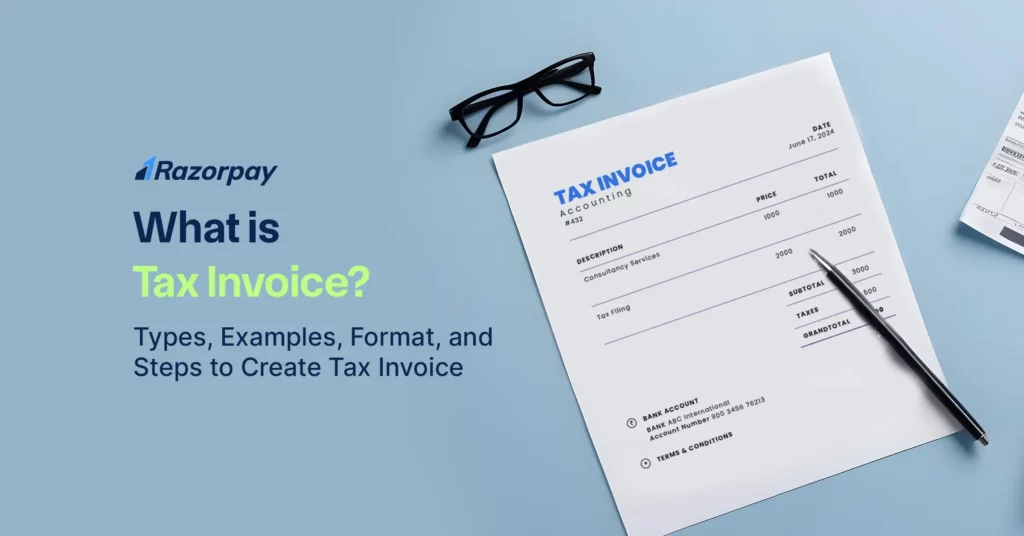Table of Contents
What Is a Tax Invoice in GST?
A tax invoice is an invoice issued for the sale of taxable goods or services. Tax invoice includes details such as the description, quantity, price, applicable taxes, and any other information required by local tax authorities.
A tax invoice is a crucial formal document issued by a seller to a buyer that describes a transaction between them. This document is essential for keeping clear financial records and complying with tax requirements.
Related Read: What Is a Commercial Invoice?
Elements/Contents of a Tax Invoice
The tax invoice must include the following critical information to ensure compliance and accuracy: Supplier and Receiver Information, Invoice Number and Date, Description of Goods/Services, Quantity and Value, Applicable Taxes, and Total Amount Payable.
For clarity and completeness, the following optional details can be included:
- Invoice number: A unique identifier for the invoice.
- Invoice date: The date of invoice generation.
- Customer name and details: Complete name, shipping, and billing addresses.
- Customer and supplier GSTIN: Unique identification numbers for tax purposes.
- Place of supply: The location where the goods or services are deemed to be supplied.
- HSN/SAC code: Harmonized System of Nomenclature or Services Accounting Code for product or service classification.
- Item details: Description, quantity, unit, and total value of each item.
- Total value: The overall value of the transaction.
- Taxable value and discounts: The amount subject to tax after applying discounts.
- GST rates and amounts: Applicable GST components (CGST, SGST, IGST) and their corresponding values.
- Reverse charge: Indication if GST is payable on a reverse charge basis.
Supplier signature: Authorization of the invoice.
Tax Invoice Format
The below example illustrates a tax invoice format.

How to Create a Tax Invoice? A Step-by-Step Guide
Creating a tax invoice entails numerous stages to ensure that all relevant information is appropriately collected.
Here’s a step-by-step instructions:
STEP 1: Gather the required information
Collect all required information, including supplier and recipient information, GSTIN, description of goods/services, quantity, unit price, and appropriate tax rates.
These details are crucial for compliance with GST laws, ensuring transparency and accuracy in tax calculations.
STEP 2: Choose or create a template
Choose between using a pre-made template and creating a new one. Ensure the template has all the fields required for a comprehensive and valid tax invoice.
STEP 3: Fill in the details
After deciding on a tax invoice format, enter all transaction details, including the unique invoice number, dates, addresses, description of goods/services, quantity, and unit pricing in the specified sections on the invoice.
STEP 4: Calculate taxes
Calculate the relevant taxes using the applicable rates (such as CGST, SGST/UTGST, or IGST) and the value of the goods/services. and calculate the total amount payable.
STEP 5: Review and finalize
Review the invoice completely for correctness and completeness. Check for mistakes and omissions, and repair as required.
STEP 6: Send the invoice
Send the final invoice to the recipient. This can be accomplished electronically by email or by traditional mail, depending on the preferences and capabilities of both parties.
Read About: How to Send an Invoice?
Example of a Tax Invoice
Imagine a company, RZ Electronics, selling a laptop to a customer XYM for ₹10,000. The tax invoice would itemize the buyer and seller details, invoice number, date, product details, quantity, and value. Additionally, it would specify the tax rates and amounts, such as an 18% GST.
In this scenario, the tax invoice would calculate a total tax amount of ₹1,800, leading to a total payable amount of ₹11,800. It is issued by RZ Electronics to XYM, ensuring a transparent record of the transaction. This clarity helps the organization comply with tax laws and mitigates the risk of disputes or legal complications in the future.
Comparison Between Tax Invoice and Receipts
Understanding the distinction between a tax invoice and a receipt is essential for proper financial management and tax compliance. While both documents are commonly used in business transactions, they serve different purposes and are issued at different stages of the payment process.Here, the table represents the differences between a tax invoice and a receipt:
| Basis | Tax Invoice | Receipt |
| Purpose | Requests payment for goods or services provided | Acknowledges that payment has been received |
| Timing of Issue | Issued before or at the time of payment | Issued after payment is received |
| Content | Includes itemized goods/services, tax details, invoice number, buyer and seller details, due amount | Includes amount paid, payment date, receipt number, and mode of payment |
| Accounting Role | Used to record accounts receivable and claim tax (GST/VAT) | Used to confirm revenue received and update cash flow |
| Legal Significance | Serves as a valid document for tax input claims and compliance | Serves as proof of payment for audit or dispute resolution |
| Use in Tax Filing | Required to claim input tax credit (e.g., GST) | Cannot be used for tax credit claims |
Why are Tax Invoices Important in GST?
Tax invoices are essential for both parties to monitor sales and purchases, simplify tax reporting, and ensure compliance with tax laws. They serve as proof of transactions, useful for audits and disputes, and are a crucial part of business record-keeping and accounting. Tax invoices provide a clear and organized record of all sales transactions, which can be used for tax reporting, financial analysis, and other purposes.
Here’s how they benefit buyers and sellers:
1. Buyers
Claiming Input Tax Credit (ITC)
Buyers can utilize tax invoices to claim Input Tax Credit (ITC) of taxes paid on purchases against taxes owed on their own sales, lowering total tax obligation.
Proof of Purchase
A tax invoice acts as evidence of a lawful company expense, which is required for taxation purposes.
2. Sellers
Proof of Sale
A tax invoice helps to document the sale of products or services for accounting purposes. This record assists in reconciling sales and ensuring that all transactions are appropriately logged.
Tax Collection and Reporting
A tax invoice is a formal record of the taxes received from the buyer. This paperwork is required to report taxes to the government and ensure compliance with tax legislation.
When Is a Tax Invoice Required?
A tax invoice is required when a taxable sale of goods or services occurs. It is essential for transactions where the buyer needs to claim tax credits or deductions. Typically, businesses must issue a tax invoice within a specified period after the sale, as mandated by tax laws.
Types of Tax Invoices
Tax invoices are documents issued by sellers to buyers, detailing the transaction and applicable taxes and ensuring that the transaction is properly documented and that both parties have a clear sales record. Different types of tax invoices are used based on organization needs and tax jurisdiction requirements.
1. Full Tax Invoice
A Full Tax Invoice is a comprehensive document detailing all aspects of a transaction. It includes in-depth information about both the buyer and seller, a precise description of goods or services, quantities, unit prices, transaction date, invoice number, and applicable taxes. This level of detail is typically required for larger, complex transactions.
Example of Full Tax Invoice
When VPN Ltd. purchases industrial equipment from GHI Industries, a full tax invoice would itemize each piece of equipment, specifying its quantity, price, and associated taxes. This granular breakdown ensures accurate tax calculations and record-keeping for both parties.
2. Simplified Tax Invoice
A simplified tax invoice provides a condensed overview of a transaction, encompassing essential details while omitting extensive specifics. Unlike its more comprehensive counterpart, it offers a basic summary rather than a detailed breakdown.
Example of Simplified Tax Invoice
When purchasing items from a typical retail store, customers receive a simplified tax invoice. This document typically includes the total purchase amount, applicable taxes, and a general description of the goods or services.
3. Electronic Tax Invoice (E-invoice)
An Electronic Tax Invoice is a digital equivalent of a traditional tax invoice, generated and delivered electronically. This modern approach streamlines processes and enhances efficiency. Due to its convenience and speed, electronic tax invoicing is rapidly gaining popularity. E-commerce platforms commonly utilize electronic tax invoices for online purchases.
Example of Electronic Tax Invoice
When a customer buys software online, the seller instantly generates an e-invoice detailing the product, taxes, and total amount due. This digital document is typically sent via email or fax, providing a convenient and compliant record for both parties.
4. Tax Invoice For Exports
An Export Tax Invoice is specifically designed for transactions involving the sale of goods to buyers located outside the seller’s country. In addition to standard tax invoice details, it includes essential information required for customs clearance and compliance with international trade regulations.
Example of Tax Invoice for Exports
When a business sells products to an overseas buyer, an export tax invoice includes details like product descriptions, prices, applicable taxes, and shipping information, ensuring smooth customs processing and adherence to trade regulations.
Related Read: 15 Types of Invoices: Meaning, Examples and Key Elements
Comprehensive Guidelines for Tax Invoicing Compliance in India
Issuing tax invoices in India necessitates adherence to various legislative standards.
These standards are as follows:
Legal requirements for tax invoices in India
Tax invoices in India must adhere to specific legal requirements to ensure compliance with GST laws.
These requirements include:
1. Supplier and recipient information
The invoice must include the names, addresses, and GSTINs of both the supplier and the receiver.
2. Description of Goods/Services
A detailed explanation of the products or services offered.
3. Quantity and value
The number of products or services provided, along with their worth or cost.
4. Tax rates and amounts
A breakdown of the applicable taxes (CGST, SGST/UTGST, and IGST) and the associated amounts.
5. Date of issuance
The date when the tax invoice was issued.
Meeting these GST law requirements is crucial for ensuring accurate tax reporting, maintaining transparency, and avoiding legal complications.
Timelines for issuing tax invoices
1. For Commodities/Goods
A tax invoice must be issued at or before the moment the products are removed for supply. This ensures that the invoice is created once the products are sent or delivered.
2. For Services
A tax invoice must be given within 30 days after the date of provision of services. This gives the seller enough time to prepare and issue the invoice once they’ve provided the service.
For example, As a manufacturer, X shipped items on July 1st 2025 and must provide a tax invoice on or before this date. A service provider who completes a service on July 1st, 2025, shall issue the invoice before July 31, 2025. Adherence to these deadlines assures GST compliance and seamless transaction processing.
Penalties for Non-compliance
Businesses face severe penalties if they fail to comply with tax invoicing regulations.
1. Failure to issue correct invoices
Penalties can be levied if invoices are not issued with the appropriate details or within the prescribed time frame. Fines can vary from monetary penalties of up to ₹10,000 to legal measures.
2. Failure to maintain accurate records
Businesses must keep accurate records of all transactions. Inaccurate or incomplete records may result in penalties, fines of up to ₹25,000, and heightened attention during audits.
3. Deliberate issuance of false invoices
It is a criminal offense. Penalties include heavy fines, legal action, and even 5 years’ jail time. The harshness of fines emphasizes the significance of following tax regulations.
4. Penalty Payable
If businesses fail to comply with tax invoice regulations, they might be required to pay a penalty ranging from 100% to 200% of the invoice value. There can also be interest and a 100% penalty for the evaded tax. The amount may vary depending on regulations.
Best Practices for Issuing Tax Invoices
Using best practices for producing tax invoices provides a seamless and legal invoicing process.
Here are a few crucial practices:
STEP 1: Gather Essential Information
- Collect comprehensive details about the supplier and recipient, including names, addresses, and GSTINs.
- Accurately describe the goods or services provided, specifying quantities, unit prices, and HSN or SAC codes.
- Determine the applicable GST rates (CGST, SGST, or IGST) based on the nature of the transaction and place of supply.
STEP 2: Select a Suitable Template
- Choose a pre-designed tax invoice template or create a custom format that aligns with GST regulations.
- Ensure the template includes all mandatory fields and provides clear sections for essential information.
STEP 3: Populate Invoice Details
- Enter the unique invoice number, invoice date, and delivery date.
- Provide clear descriptions of goods or services, including quantities, units, and unit prices.
- Specify the place of supply, order/purchase order number (if applicable), and shipping/delivery address.
STEP 4: Calculate Taxes Accurately
- Determine the taxable value of the goods or services after applying any discounts or rebates.
- Calculate the applicable GST amount based on the GST rates and taxable value.
- Clearly display the total invoice value, including taxes.
STEP 5: Review and Verify
- Thoroughly check the invoice for errors in calculations, spelling, and formatting.
- Ensure all mandatory fields are completed accurately and consistently.
- Verify the correctness of the recipient’s and supplier’s details.
STEP 6: Issue the Invoice
- Send the completed tax invoice to the recipient via email, post, or other electronic means.
- Retain a copy of the invoice for your records and GST compliance.
Create your Invoices with Razorpay Invoicing Software
How Many Copies of a Tax Invoice Should Be Issued?
For Supply of Goods:
- Original Invoice: Sent to the customer, marked as “original for the recipient.”
- Duplicate Copy: Sent to the transporter, marked as “duplicate for transporter.” The transporter needs this for evidence during the transport of goods.
- Triplicate Copy: Kept by the supplier for their records, marked as “triplicate for supplier.”
For Supply of Services:
- Original Invoice: Sent to the customer, marked as “original for the recipient.”
- Duplicate Copy: Kept by the supplier for their records, marked as “duplicate for supplier.
Conclusion
Tax invoices are a cornerstone of India’s financial and tax processes. They are essential for maintaining transparency, accuracy, and compliance. Businesses that follow regulatory standards and best practices can keep accurate records, promote seamless transactions, and avoid penalties. Ensuring the accuracy and comprehensiveness of tax invoices is vital for both buyers and sellers in navigating the complicated tax landscape while upholding sound financial habits.
Related Read: Difference Between an Invoice and Receipt
Frequently Asked Questions (FAQs)
1. How is a tax invoice different from a receipt?
The seller issues the customer a tax invoice, which specifies the transaction, including the price, quantity, and relevant taxes. In contrast, a receipt serves as verification of the buyer’s payment. While an invoice seeks payment, a receipt confirms that payment was made.
2. How do tax invoices relate to VAT/GST?
Tax invoices are critical for VAT/GST systems because they reflect the taxes levied on sales and enable organizations to claim input tax credits. They guarantee that taxes are collected and reported appropriately, which helps VAT/GST systems run smoothly.
3. What is the difference between a GST invoice and a tax invoice?
A GST invoice is a sort of tax invoice issued under the Goods and Services Tax system. It provides additional information required by GST laws, such as both parties’ GSTIN, HSN code for goods, and SAC code for services. While all GST invoices are tax invoices, not all tax invoices are GST invoices.
4. Who issues tax invoices?
The vendor or service provider issues tax invoices to the buyer or recipient of goods or services. The seller is responsible for including all required information and ensuring that the invoice complies with applicable tax legislation.
5. What is the time limit to issue a tax invoice?
The timeframe for issuing a tax invoice depends on the type of transaction. For goods, the invoice must be issued at the time of removal or delivery. For services, it should be issued within 30 days of completing the service
6. How long do I need to keep tax invoices?
Tax invoices should be kept for the minimum term required by tax legislation, which is normally 6 to 8 years. This ensures that they are available for audits and compliance inspections.
7. Do I need to issue a tax invoice for every sale?
A tax invoice should be provided for any taxable sale of goods or services. This guarantees correct documentation for tax purposes and helps both parties maintain accurate records.
8. What is the difference between a commercial invoice and a tax invoice?
A commercial invoice is largely used in international commerce and contains information required for customs clearance, such as country of origin, customs codes, and export data. In contrast, a tax invoice focuses on recording the transaction and any related taxes within the local tax jurisdiction.



